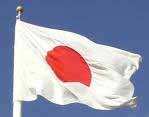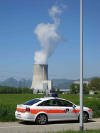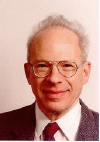|


Not only in Japan, the «Climate Change by
Radioactivity» is produced for a long time, but in Fukushima
since 11.3.2011 it is
released...
cf.
UN-Resolution
«Climate Change by Radioactivity», SolarPeace.org,
7.8.2009
|
Following the nuclear disaster in
Fukushima/Japan all Swiss nuclear power plants and the ENSI were asked for
information about the daily amount of radioactivity produced and the total
existent radioactivity levels in each of the respective nuclear power
plants. At the same time the nuclear power plants and the ENSI were asked to
disclose these levels of radioactivity in comparison with the radioactivity
released by the Hiroshima nuclear bomb. The resulting correspondence
is impressive.3)..7)
Despite registered letters, the nuclear power plant Leibstadt did not reply
to the first request. The response from the nuclear power plants Beznau (AXPO),
Mühleberg (BKW) and Gösgen (ALPIQ) were evasive and failed to address the
questions. They only referred to internet sites and publications by the
Federal Office for Energy (BFE), the Federal Office of Public Health (BAG),
the National Emergency Operations Centre (NAZ) and the Swiss Federal Nuclear
Safety Inspectorate (ENSI). All nuclear power plants were contacted again.
|
1)
cf.
JAPAN nuclear catastrophe: UN Resolution on Security and energy needed
urgently!, SolarPeace.org, 18.3.2011
cf.
The Catastrophe of Fukushima, Video speech by the physician,
author and speaker Dr Helen Caldicott, 15.5.2011
cf.
Internal Radioactive Emitters – Invisible, Tasteless, and Odorless, Dr
Helen Caldicott, 14.7.2011
cf.
Radioactive contamination in Fukushima: "Food is nuclear waste",
video of a
ZDF-Frontal21 broadcast in Japan, Fukushima
Central Television, 28.8.2011;
cf. the original broadcast:
The consequences of Fukushima, ZDF, 9.8.2011
|
|

Swiss nuclear power plant locations
|
The Swiss Federal Nuclear Safety
Inspectorate (ENSI) is the "Federal regulatory authority for nuclear
safety of the Swiss nuclear power plants".2)
When asked the same questions
about radioactivity in the nuclear power plants, the ENSI replied, that the
duties of the ENSI include the «supervision of the
safety of the Swiss nuclear facilities» and the
«potentially releasable radioactivity», but not the
«produced and accumulated radioactivity» as
requested. They suggested «please contact the
operators of the nuclear power plants directly».
Additionally the ENSI confirmed that the data on radioactivity in nuclear power plants and
the comparison with the Hiroshima nuclear bomb on the website SolarPeace.org
are correct and stated: «In this respect, your
questions are answered on your linked website». Thanks - But how can
a regulatory body assess the risk and safety of nuclear power plants without
knowing the amount of radioactivity produced, thus without knowing the cause
of the risk of nuclear power plants? A reply from ENSI to the second letter
dated 1.7.2011 is still pending.3) |
2)
cf.
Mandate of
Swiss Federal Nuclear Safety Inspectorate (ENSI),
inauguration of ENSI, 30.4.2009
cf.
«Openness and Transparency», ENSI Direktor Hans Wanner,
6.6.2011
cf.
«Arbitrariness ("severe perversion of the course of justice") by the ENSI
must be stopped», Greenpeace und Prof.
Dr. iur. Heribert Rausch, 28.8.2011
3)
cf.
correspondence with
Swiss Federal Nuclear Safety Inspectorate ENSI, SolarPeace.org,
1.4.2011 to 1.7.2011 (einschl.
Mitteilung der Umfrageergebnisse vom 31.8.2011 und der später nachgefragten
Antwort des ENSI vom 12.6.2012)
see also
The ENSI acts as if it would do something, "Energy expert Rudolf
Rechsteiner explains how systematically the nuclear power plant operators
are being protected instead of the population.",
TRAS,
28.11.2013 and
"Rudolf Rechsteiner wants to legally enforce retrofits that become too
expensive for the operators of nuclear power plants",
TRAS,
5.12.2013
|
|

©
Atominfomedia, 27.7.2011
(CH-AKW
als Anschlagziel)
|
The nuclear power plant Gösgen (ALPIQ)
replied to the second inquiry on produced radioactivity with
«daily 3.3 kg of radioactive fission products»
(see the gross output: Gösgen 1035 MW, Mühleberg 390 MW),
«during operation, the entire inventory amounts to
approximately 8E8 TBq, if the reactor is shut down it is in a percentage
level thereof» and explained that a comparison with the radioactivity
of the Hiroshima nuclear bomb is «not possible».
As this response says little (see the explanation of BKW), is difficult to
understand and impossible to compare for lay people, they were asked for a
response to all questions and for an explanation of «inventory .. 8E8 TBq»
(see: 8E8 TBq = 800'000'000'000'000'000'000 Bq = 800 trillion becquerel).
Hereupon the nuclear power plant Gösgen (ALPIQ) replied only,
«For further clarification of your questions, we
recommend .. the consultation of relevant specialist literature». A
reply from the nuclear power plant Gösgen to the fourth letter dated
14.8.2011 is still pending.7) |
7)
cf.
correspondence
with
nuclear power plant Gösgen (ALPIQ), SolarPeace.org, 1.4.2011
to 14.8.2011
Notes:
●
8E8 = 8 x 108 = 800'000'000
●
T = Tera = 1012 = 1.000.000.000.000 =
Billion
●
E = Exa = 1018 = 1.000.000.000.000.000.000 =
Trillion
cf.
Vorsätze für Maßeinheiten (SI-Präfixe), Wikipedia.org
cf.
Becquerel (Bq), the unit
of
Radioactivity, Wikipedia.org
|
|

©
Prof. Dr.
Richard L. Garwin (Atomphysiker) 8)
«A reactor in one day produces as much
radioactivity
as a 50-kt nuclear explosion.»8)
«The quantity of radioactivity, which is present in a reactor, is larger
than the quantity of radioactivity spread by a nuclear bomb - significantly
larger.»
Prof. Dr. C. F. von Weizsäcker,
nuclear physicist, cf.
Atomkraftwerke und Jod-Tabletten: "Risiken und Nebenwirkungen ...",
SolarPeace.org, 12.11.2004, and
the
«Packungsbeilage Atomstrom...»

 ! !

Order at your electricity supplier a
natural power / green energy, which also includes a portion of solar
power...

 |
The
result of the survey based on the responses received is sobering.
a)
No Swiss nuclear power plant knows how much radioactivity is produced per
day.
b)
Only the nuclear power plant Gösgen (ALPIQ) was able to state the total
radioactivity present, but refused further explanation.
c)
No nuclear power plant could give understandable and meaningful information
regarding the produced radioactivity and the comparison with the Hiroshima
nuclear bomb.
Conclusion: Nuclear power plant operators who do not know «what»
and «how much» they produce, cannot assess the risk and therefore cannot
take adequate safety precautions. Since even the Federal Nuclear Safety
Inspectorate (ENSI) has stated that they do not know the radioactivity in
the Swiss nuclear power plants (and thus cannot fulfill their mandate), the
Swiss Federal Council (Bundesrat) is responsible for checking, whether these
nuclear power plants must immediately be taken off the grid for safety
reasons.
It is
high time that we are fully aware of the core question and the core problem:
What does a nuclear power plant produce?
1.) Radioactivity
2.)
Electricity
Already in April 2001, the U.S. nuclear physicists Richard L. Garwin
explained the amount of radioactivity in a nuclear power plant at the
Nuclear Control Institute in Washington: «Since a
reactor in one day produces as much radioactivity as a 50-kt nuclear
explosion, and fuel in a reactor has typically been there for an average of
two years, a typical nuclear reactor has in its core the long-lived
radioisotopes from 30 megatons of fission.» (Richard L. Garwin, «Can
the World Do Without Nuclear Power? Can the World Live With Nuclear Power?»,
Nuclear Control Institute, 9.4.2001).8)
The Hiroshima nuclear bomb represented a 12.5 kt nuclear explosion. Thus, an
average nuclear power plant produces a daily quantity of radioactivity
equivalent to four Hiroshima nuclear bombs, which each year adds up
to radioactivity in the order of magnitude of 1460 Hiroshima nuclear
bombs. In a nuclear reactor radioactivity exists even in the order of
magnitude of 2920 Hiroshima nuclear bombs (the production of two years).
Thus the five Swiss nuclear power plants contain radioactivity in an order
of magnitude of approximately 10’000 Hiroshima nuclear bombs and threaten
not only the Swiss population, but also the population of neighbouring
countries. This is a violation of constitutional principles, human rights
and international law.10)
US nuclear physicist Richard L. Garwin summarises:
«Reactor accidents... too horrible to think about.», by which he is
sadly not only right but also appeals to the need for responsible reflection
by political decision makers.8)
After the nuclear disaster in Fukushima the Swiss Federal Council and the
National Council have made a policy decision to phase out nuclear power. The
Council of States must still confirm this policy decision to enable design
and implementation of the energy transition now without further delay.11)
This decision is about the security of the
population, but it is also about the issues of electricity price and
security of supply. These questions can best be answered by the people of
Fukushima and Japan.1)
and 12)
As Bloomberg reported, the Japanese billionaire Masayoshi Son together with
Japan's government is planning to replace two-thirds of today's nuclear
electricity with solar power (incl. «roof-top solar
panels at 10 million homes»). This is possible in Switzerland too.13)
«To see the problem is more important than finding the
solution,
for accurate representation of the problem leads almost
automatically to the correct solution.»
(Albert Einstein)
|
8)
cf. «Can the World Do Without Nuclear Power? Can the
World Live With Nuclear Power?», Prof. Dr.
Richard L. Garwin (nuclear physicist), Nuclear
Control Institute, 9.4.2001 (cf.
copy page 5 and
copy page 6
 ) )
see also
Fukushima - Nuclear explosion by Super-GAU?
 ,
SolarPeace.org, 11.3.2012, summary (2 pages) of the TV
documentation
Fukushima - The truth behind the Super-GAU, TV ARTE,
6.3.2012 (52min video in German or French), «People are burdened with doses that are much higher
than during the time of testing nuclear bombs ... 1000-times higher in the
one-hundred-km zone.», Prof. Christopher Busby, radiation chemist; «It can
not be excluded that there has been a nuclear explosion in reactor 3.», Prof. Yukio Yamaguchi, Director Citicens' Nuclear
Information Center, Tokyo ,
SolarPeace.org, 11.3.2012, summary (2 pages) of the TV
documentation
Fukushima - The truth behind the Super-GAU, TV ARTE,
6.3.2012 (52min video in German or French), «People are burdened with doses that are much higher
than during the time of testing nuclear bombs ... 1000-times higher in the
one-hundred-km zone.», Prof. Christopher Busby, radiation chemist; «It can
not be excluded that there has been a nuclear explosion in reactor 3.», Prof. Yukio Yamaguchi, Director Citicens' Nuclear
Information Center, Tokyo
see also
«The spent
fuel from nuclear plants contains enough plutonium to fabricate about 30
nuclear weapons from a single year of operation of each power reactor.», Prof. Dr.
Richard L. Garwin (nuclear physicist), «The Future of Nuclear Energy,»,
Chicago, 25./26.9.2008 (Copy
 ) )
9)
cf.
Hiroshima nuclear bomb à 12.5 kt (Copy
 ),
International Physicians for the Prevention of Nuclear War (IPPNW,
Peace Nobel Price 1985,
www.facts-on-nuclear-energy.info) ),
International Physicians for the Prevention of Nuclear War (IPPNW,
Peace Nobel Price 1985,
www.facts-on-nuclear-energy.info)
10)
cf.
«UN Declaration of Human Rights should be applied to the question of avoidable radiation exposures»,
ECRR 2003 - Recommendations of the European Committee on
Radiation Risk, Brussels 2003
cf.
Bundesverfassung der Schweizerischen Eidgenossenschaft, «Präambel:
Im Namen Gottes des Allmächtigen ... Verantwortung gegenüber der Schöpfung
... Unabhängigkeit und Frieden ... Verantwortung gegenüber den künftigen
Generationen ...», 18. April 1999 (Stand am 3. März 2013), admin.ch
cf.
Gemeinderat Kilchberg
informiert über Radioaktivität & Lösung Naturstrom... Legislaturziel:
Erhaltung der Lebensgrundlagen, SolarPeace.org,
25.11.2008
cf.
Antwort der Österreichischen Regierung zur SolarPeace-Pressemitteilung
«Klimawandel durch Radioaktivität», Bundeskanzleramt Österreich,
7.10.2009
11)
cf.
Sessionsprogramme Ständerat, Herbstsession, 12. - 30. September 2011
cf.
Schweiz: Bundesrat beschliesst Atomausstieg, admin.ch, 25.05.2011;
«Profitieren kann die Schweiz auf allen Ebenen», Tagesanzeiger, 27.5.2011;
«Wenn's einer schaffen kann, dann wir!», SF Arena, 28.5.2011;
Das unerwartet deutliche JA zum Atomausstieg, NZZ, 8.6.2011
12)
cf.
Damages due to the nuclear disaster in Fukushima already at 90 to 100
billion Euro,
Sonnenseite.com, 8.8.2011 and
Fukushima-operator makes billion-dollar loss, Spiegel Online, 9.8.2011
cf.
Fukushima Study on Liability Issues: «Generally
unlimited liability of nuclear plant operator TEPCO»
and «Is the Japanese
government liable due to lack of nuclear supervision?», Max-Planck-Gesellschaft
zur Förderung der Wissenschaften e.V., 19.8.2011 (Kopie
 ) )
cf.
4300 billion Swiss Francs cost of risk by nuclear energy
 in the study "Verbesserte Deckung des Nuklearrisikos
- zu welchen Bedingungen?",
Bundesamt für Energie (Dezember 2000) in the study "Verbesserte Deckung des Nuklearrisikos
- zu welchen Bedingungen?",
Bundesamt für Energie (Dezember 2000)
cf.
Atommeiler nicht versicherbar and Munich RE-Chef Von Bomhard in
Schäden durch Super-GAU lassen sich kaum absichern,
WELT ONLINE, 20.3.2011 und auch
Nuclear Expensive and Uninsurable (with insurance up to $3.40/kWh), Sonnenseite.com 2011
cf.
"Die AKW Begeisterung steckt tief im Kühlturm" (Atomstrom 3 CHF/kWh)
 , 3.3.2000,
CASH;
and the study quoted therein "Privatisierung der
KKW-Haftung in der BRD", Gutachten der Regierung Kohl (CDU/CSU/FDP),
Sept. 1992; and
Atomstrom würde 5 CHF/kWh kosten ... , 3.3.2000,
CASH;
and the study quoted therein "Privatisierung der
KKW-Haftung in der BRD", Gutachten der Regierung Kohl (CDU/CSU/FDP),
Sept. 1992; and
Atomstrom würde 5 CHF/kWh kosten ... ,
"Atompläne: Unverantwortlich und kurzsichtig",
Greenpeace, 24.5.2005 ,
"Atompläne: Unverantwortlich und kurzsichtig",
Greenpeace, 24.5.2005
13)
cf.
Japan’s Richest Man Takes on Atomic Future With Solar Plans, Bloomberg,
15.6.2011 and
Solarrevolution auf Japanisch, Solarmedia, 16.6.2011 and
Saudi-Arabien: Weltgrößte Solaranlage, Sonnenseite.com, 30.03.2018
cf. "...realisierbares Potential von 30
bis 50%.", HAUS TECH Nr. 11, 2004,
Handelszeitung
Fachverlag; and "Gemäss einer EU-Studie könnte 2010 mehr als ein Viertel
des schweizerischen Stromverbrauchs auf Dächern produziert werden - mit
Photovoltaik-Anlagen" (18.6.1997) and
20% Solarstrom (PV) des heutigen Stroverbrauchs
 ,
Greenpeace, 12.5.2011; see
also AEE - Agentur für erneuerbare
Energien und Energieeffizienz: "ein Drittel des heutigen Strombedarfs" (Energie
von der Sonne), 2011 ,
Greenpeace, 12.5.2011; see
also AEE - Agentur für erneuerbare
Energien und Energieeffizienz: "ein Drittel des heutigen Strombedarfs" (Energie
von der Sonne), 2011
cf.
China : government incentive delivers massive upside to Solar market,
Sonnenseite.com, 16.8.2011
cf. «Natural
Power – Lifestyle and Necessity», SolarPeace.org,
2.5.2008
cf.
'At the floodgates' of a solar energy boom, "Solar energy, together with
wind power, can potentially tackle the task of transforming the global
energy system...", Eicke Weber, director at Fraunhofer Institute, 29.12.2013 |